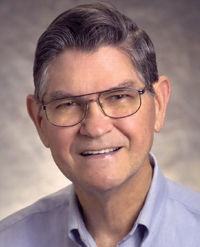
Ned H. Burns
Ph.D., University of Illinois-Urbana, 1962
M.S., The University of Texas at Austin, 1958
B.S., The University of Texas at Austin, 1954
Inducted, 2003
An expert in prestressed concrete, Ned Burns (deceased), was the first to test the concept of banded tendons, which is now standard industry practice for slab construction. He was inducted into the National Academy of Engineering in 2000 “for contributions to development and education in prestressed concrete, including unbounded tendon building slabs and high-performance concrete bridges." An outstanding teacher, administrator and structural engineering researcher, he served UT for nearly 40 years.
Burns began his career at The University of Texas at Austin as an assistant professor in 1962. He enjoyed a successful career in teaching and directing Structural Engineering Research until he retired in 2001. He became a professor in 1972 and, in 1983, was named Zarrow Centennial Professor. He was Associate Dean of Academic Affairs for Engineering from 1989-1993.
Burns received 11 awards for outstanding teaching and advising at the undergraduate and graduate levels from the department, college and university levels at The University of Texas at Austin. He began prestressed concrete research at UT in 1963 and was the first to test the concept of banded tendons, which is standard industry practice for slab construction.
He served as chairman of the ACI/ASCE Prestressed Concrete Committee and was on the Board of Directors of ACI and PTI. He authored more than 55 technical papers in major structural engineering journals and presented at various conferences throughout the world. His co-authored textbook, "Design of Prestressed Concrete," with T.Y. Lin, has been the sourcebook in the industry for the analysis and design of prestressed structures for many decades.
The ACI awarded him the Joe W. Kelly Award in 1990 in recognition of his contribution to education and the PCI Distinguished Professor Award in 2000. Burns was a fellow of the ACI, PCI, PTI and ASCE and was named Engineer of the Year by the Travis Chapter of the Texas Society of Professional Engineers in 2000. He was elected to membership in the National Academy of Engineering in recognition of his contribution to education and research in prestressed concrete and high-performance prestressed concrete bridges.







